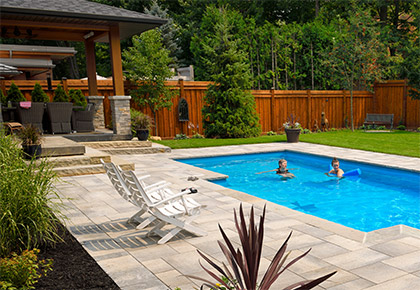Monday February 12, 2024
A guide to understanding your HOA backyard rules
 When you live in a Homeowners Association (HOA) you agree to abide by property regulations, including those governing backyard modifications. For many homeowners, the desire to customize their outdoor space can clash with the stringent guidelines imposed by their HOA. In this article, we answer the most frequently asked questions regarding HOA backyard rules as well as steps for requesting an architectural modification to your home.
When you live in a Homeowners Association (HOA) you agree to abide by property regulations, including those governing backyard modifications. For many homeowners, the desire to customize their outdoor space can clash with the stringent guidelines imposed by their HOA. In this article, we answer the most frequently asked questions regarding HOA backyard rules as well as steps for requesting an architectural modification to your home.What is an architectural modification?
An HOA architectural modification refers to any alteration, addition, or renovation to the exterior of a property that changes its appearance or structure. This can include modifications to the façade, roofing, landscaping, hardscaping, fencing, or any other visible elements of the property. Since HOAs aim to maintain uniformity and uphold community standards, they often require homeowners to seek approval before making any architectural modifications to their properties.How to request an architectural modification to your property?
The typical process for requesting and completing an HOA architectural modification involves several steps:- Review HOA guidelines: Homeowners should carefully review the HOA's governing documents or bylaws, such as the Covenants, Conditions, and Restrictions (CC&Rs), Architectural Guidelines, or Design Standards. These documents outline the specific requirements and procedures for architectural modifications within the community.
- Prepare modification proposal: Before submitting a formal request to the HOA, homeowners should prepare a detailed proposal outlining the proposed modification. This may include architectural drawings, material specifications, color samples, and any other relevant documentation necessary to illustrate the intended changes.
- Submit modification request: Once the proposal is complete, homeowners must submit a formal modification request to the HOA. This request typically includes the proposal documentation, along with any required application forms or fees specified by the HOA.
- HOA review process: The HOA's architectural committee or board of directors will review the modification request to ensure compliance with community guidelines and standards. This review may involve assessing the proposed modification's impact on aesthetics, property values, and overall harmony within the community.
- Approval or denial: After reviewing the modification request, the HOA will either approve or deny the proposal. Approval may be granted outright, or it may be contingent upon certain conditions, such as revisions to the proposal or adherence to specific guidelines.
- Implementation: If the modification request is approved, homeowners can proceed with implementing the proposed changes. This may involve hiring contractors, obtaining necessary permits from local authorities, and completing the work according to the approved plans.
- Final Inspection: Once the modification is complete, the HOA may conduct a final inspection to ensure that the work was carried out in accordance with the approved plans and meets community standards.
- Compliance and maintenance: Homeowners are responsible for maintaining the modified elements in compliance with HOA guidelines and standards. Failure to do so may result in fines or other enforcement actions by the HOA.
How long does HOA approval take for modification?
The duration of HOA approval for backyard modifications varies depending on the complexity of the project and the efficiency of the HOA's review process. While some simple alterations may receive swift approval, more extensive projects involving structural changes could entail longer deliberation periods. It's advisable to consult with the HOA regarding expected timelines and factors that may expedite or prolong the approval process.
Other frequently asked questions
-
Can an HOA control a backyard?
HOAs exert authority over various aspects of homeownership, including the use and appearance of backyard spaces. While homeowners technically own their backyard, they must adhere to HOA backyard rules governing landscaping, hardscaping, and architectural modifications. These rules aim to maintain a cohesive aesthetic and preserve property values within the community.
-
Can HOAs fine you for your backyard?
HOAs possess the authority to levy fines against homeowners who violate community rules, including those pertaining to backyard modifications. Fines may escalate for repeated infractions or failure to comply with HOA directives. To avoid penalties, homeowners should familiarize themselves with HOA guidelines and seek approval for any proposed changes to their outdoor spaces.
-
Do you need HOA approval for a patio?
The installation of a patio in your backyard typically falls under the purview of HOA guidelines. While specific regulations may vary depending on the community, it's common for HOAs to require approval for any structural modifications to your property, including the addition of a patio. This approval process ensures that the proposed changes align with the aesthetic and architectural standards set by the HOA.
-
What happens if you build a patio without HOA approval?
Proceeding with patio construction without obtaining HOA approval can have significant consequences. In most cases, the HOA reserves the right to enforce penalties or compel the removal of unauthorized structures. Homeowners may face fines, legal action, or the obligation to dismantle the patio at their own expense. Such infractions can strain relations with the HOA and impact property resale value.
-
Can my HOA trespass on my property?
While HOAs have the right to enforce community regulations, they must do so within the boundaries of the law. Trespassing onto private property without consent is generally prohibited, and HOA representatives should respect homeowners' privacy rights. However, HOAs may conduct routine inspections of common areas or request access to inspect approved modifications within a homeowner's property boundaries.
To learn more about HOA backyard rules or to learn how a professional management company like FirstService Residential can support your community contact a member of our team.